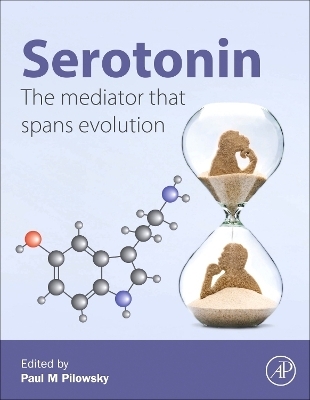
Serotonin
Academic Press Inc (Verlag)
978-0-12-800050-2 (ISBN)
Finally, it discusses the role of serotonin system dysfunction in a variety of pathophysiological conditions, including sleep apnea, obesity and hypertension, and presents compelling evidence that this dysfunction is involved in Sudden Infant Death Syndrome (SIDS).
Paul M Pilowsky began BMedSci(Hons), BMBS, PhD his career as a graduate student investigating, inter alia, the role of brainstem and spinal cord pathways in the control of blood pressure with a focus on serotonin. His work has now been cited more than 5000 times and published in major Journals including the Journal of Neuroscience, the Journal of Comparative Neurology and the British Journal of Pharmacology. A hallmark of his work has been the adoption of, and combination of, novel approaches to address difficult questions. He pioneered the use of combining single cell electrophysiology in vivo with immunohistochemistry. His development of isotype selective monoclonal antibodies to phosphorylated tyrosine hydroxylase enabled the detection of tyrosine hydroxylase positive presympathetic neurons in the brainstem that had become excited. He was responsible for the initial development of a new medical school at Macquarie University in Sydney. His service to Neuroscience was recognised by the award of the Australian Neuroscience Medal. He mentored 26 graduate students to on-time completion, and mentored 24 post-Doctoral Fellows, many of whom now have their own established careers. In imagining this book, it was felt that a departure from the usual highly focussed text would be of interest. Hence, a multi-Author volume has been created that reveals the multiple facets of a neurotransmitter with very broad actions.
BIOPHYSICS OF SEROTONIN 1. Biophysics of Serotonin and the Serotonin1A Receptor: Fluorescence and Dynamics 2. Serotonin in plants: origin, function, and implications
ANATOMY 3. The anatomy of the serotonin system in different model systems: rat fish, flies and C. Elegans 4. Serotonin in the endocrine pancreas 5. Serotonin and platelets 6. Anatomy of the Serotonin Transporter
PHYSIOLOGY IN THE PERIPHERY 7. Cellular regulation of peripheral serotonin 8. Role of 5-HT in the control of gut motility 9. Phenotype of animals deficient in peripheral serotonin 10. Serotonin and immune system 11. Serotonin and Adipocyte Function 12. Serotonin and cardiovascular diseases 13. Involvement of 5-HT in afferent modulation of brainstem circuits regulating cardiovascular homeostasis 14. Regulation of nociceptor signalling by serotonin
PHYSIOLOGY IN THE BRAIN 15. Brain serotonin and energy homeostasis 16. Serotonin in central cardiovascular control 17. Serotonin receptors and cardiovascular control 18. Serotonin receptors as the therapeutic target for central nervous system disorders 19. Serotonin and the reconfiguration of the eupneic respiratory pattern 20. Life without brain serotonin: phenotype of animals deficient in central serotonin synthesis
| Erscheinungsdatum | 16.08.2017 |
|---|---|
| Reihe/Serie | Molecular Mediators in Health and Disease: How Cells Communicate |
| Verlagsort | San Diego |
| Sprache | englisch |
| Maße | 191 x 235 mm |
| Gewicht | 1090 g |
| Themenwelt | Medizinische Fachgebiete ► Innere Medizin ► Endokrinologie |
| Studium ► 1. Studienabschnitt (Vorklinik) ► Physiologie | |
| Naturwissenschaften ► Biologie ► Zoologie | |
| ISBN-10 | 0-12-800050-3 / 0128000503 |
| ISBN-13 | 978-0-12-800050-2 / 9780128000502 |
| Zustand | Neuware |
| Haben Sie eine Frage zum Produkt? |
aus dem Bereich


